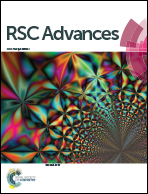Ferroelastic property of tetramethylammonium tetrachlorozincate tetrachlorocuprate, [N(CH3)4]2Zn1−xCuxCl4 (x = 0, 0.1, 0.3, 0.5, and 1)
Abstract
The various crystallographic structures of [N(CH3)4]2Zn1−xCuxCl4 (x = 0, 0.1, 0.3, 0.5, and 1) may be understood by considering the different chemical shifts observed in 1H MAS and 13C CP/MAS NMR spectra. Cu2+ ions, after replacing partially the Zn2+ ions, occupy the same locations in the lattice as the Zn2+ ions. The NMR spectrum and T1ρ of x = 0.1 and 0.3 were found to be similar to those of pure [N(CH3)4]2ZnCl4, whereas the NMR spectrum and T1ρ of x = 0.5 were different. Consequently, the existence of ferroelastic properties of N(CH3)4 ions in x = 0, 0.1, 0.3, and 1 are apparent at low temperatures, whereas they disappear for x = 0.5. It has been demonstrated that the replacement of Zn2+ ions with high concentrations of Cu2+ ions changes the ferroelastic property of the crystal.
![Graphical abstract: Ferroelastic property of tetramethylammonium tetrachlorozincate tetrachlorocuprate, [N(CH3)4]2Zn1−xCuxCl4 (x = 0, 0.1, 0.3, 0.5, and 1)](/en/Image/Get?imageInfo.ImageType=GA&imageInfo.ImageIdentifier.ManuscriptID=C4RA13846E&imageInfo.ImageIdentifier.Year=2015)

 Please wait while we load your content...
Please wait while we load your content...